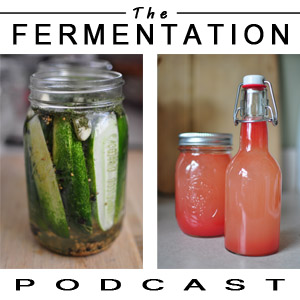Welcome to the New Year and thanks so much for joining me back again at The Fermentation Podcast!
We’re back in action and I have a feeling that this is going to be an amazing year, especially in the fermentation realm with fermented foods and beverages climbing the list of top food trends that are predicted to be hot this year.
I think it just means that people are actively regaining their health and connecting with their cultures of the past to find the knowledge that’s there that can help them into a healthy future.
Anyways, I’m back on the air and here to go over some of the things I’d like to get into in 2015 including several areas of fermentation that I’ve only recently started talking about.
I wish all of you the best of health and a great New Year!
TOPICS INCLUDED IN TODAY’S FERMENTATION PODCAST:
- Going over a bit of the end of 2014, my talk with Jane Campbell of Fermenters Kitchen and the starter that she sent me in the mail that I’m excited about! (hint: sourdough – well, maybe more than a hint)
- My plan for the new year of several different areas of fermentation including:
- Kimchi, miso, yogurt, beer, and mead
- Building more of a garden that I can use in fermentation
- Getting even more interesting people on the show to keep up with some good fermentation talks in several different areas including
- Homebrew beer
- Cheese making
- Making kombucha and maybe talks from people who run kombucheries
- Fermentation businesses
- Trying out new methods of fermentation including a very kind gift at my doorstep from The Probiotic Jar
- A list of top fermented beverages and fermented foods to get you healthy into the New Year
- A good list of healthy habits that will make your New Year the best it can be to recharge your body and your mind
RECIPES MENTIONED IN TODAY’S SHOW:
- Healing Ferments from The Fermentation Podcast’s Pinterest
- Tempeh from The Fermentation Podcast’s Pinterest
LINKS FOR TODAY’S SHOW:
- Subscribe to Email (to get updates on blogs & new shows)
- Subscribe on iTunes
- Subscribe on Stitcher Radio (Android, iPhone, etc.)
- Like us on Facebook
- Follow us on Twitter
- Follow our boards on Pinterest
- Jane Campbell’s Fermenters Kitchen Website
- Jane Campbell’s Fermenters Kitchen FB Page
- The Probiotic Jar
- Lisa’s Counter Culture
- The Movie (on Hulu): Fat Sick and Nearly Dead
I’d love to hear your thoughts on today’s show so be sure to comment below or if you have an idea for the show, email me at paul at fermentationpodcast.com or just click on the Contact button on top of this page and fill out the form. I look forward to hearing from you!
 Episode 19 - Healthy Ferments & Habits for the New Year Play Now | Play in Popup | Download
Episode 19 - Healthy Ferments & Habits for the New Year Play Now | Play in Popup | Download



4 comments
Skip to comment form
Did I hear you say fermenting garlic in honey? If so, I want to know more. I’d love to slip a teaspoon of that in my wife’s chamomile tea! This was an episode that was broader in scope than previous ones putting fermentation in perspective of the whole topic of good wholesome health through sensible diet practices. I listened to the kombucha episode and it sounded so involved I decided I’d try buying it first to see if it is worth the effort. I bought a 12 oz bottle for $3 and it was excellent. If I could make it in my Mr. Beer brewing kit which is in the closet now, I’d consider giving it a try.
With the idea of considering a wider scope of diet ideas I have to suggest my latest infatuation: broths.
https://www.youtube.com/watch?v=3ZrgETZzb0A
Today I made a bone broth following Sally Fallon’s book “Nourishing Bone Broth”. It’s incredible the amount of collagen that can be extracted from a pot full of bones, and the flavor is to die for. The trick I learned is to add ACV which extracts more nutrients and to simmer for 24 hours which triples the amount of nutrients. I always kept vegetable and meat broth in the freezer to use in soups but from the book I’ve learned that you should just keep it in the fridge and consume some everyday. Can you be a vegan and consume a bone broth? I’ve learned that I can make a broth from beef jerky batches gone wrong, and from inedible foods such as liver (to my tastes) and other organ meats. It might be that pemmican was a sort of broth plus additional ingredients. The food cakes that the Lewis & Clark expedition used was a broth based recipe that started with a bone broth with grains and veggies and fruits. They took 100 lbs of it on their journey that played a big role in their survival. I plan on making broths from foraged “weeds” this spring, especially nettles.
“Broth-ers”, brothers?
Author
Hey Richard,
Yeah you heard me right. There’s a very good ferment where you take raw honey and just drop a bunch of garlic in it and leave it for a month or so. It starts bubbling a good amount and then settles down and then the garlic gets somewhat candied. I’m sure that has some tremendous health benefits.
That’s great that you got some kombucha to try. It’s an interesting drink that I don’t drink on a regular basis but seem to go in and out of the habit of making it. It’s not hard to make though, just a jar, sugar, water, tea and the kombucha scoby and you can possibly grow it from the tea that you buy.
Thanks for mentioning broths! I know that most of the country is still in the cold and making broths whether vegetable or bone broth is a great way to make a lot of nutrients available and warm you up at the same time. Being vegan, I wouldn’t be having the actual bone broths but making vegetable broths from scraps is delicious and healthy. I do know the value of bone broths and I think the old adage about chicken noodle soup helping a cold is probably valid because of the actual bone broth. If you can get animals that were fed a much more natural diet, I think that would be best and if I had a homestead, I’d be tempted in that direction. Some of the longest-lived people on earth have broths in their diet on a regular basis.
Like you said, I’ve heard apple cider vinegar helps extract more nutrients since it acidifies the broth and I bet if you don’t have any ACV around, I’m sure pickle juice, kombucha, or any other acidic ferments would probably take its place pretty well.
That’s interesting about the Lewis & Clarke expedition with the food cakes made from broth. What an interesting thing that would be to go back in time and experience what the food was like in different periods.
Today we pressure canned 8 pints of broth from primarily pork hocks and feet. From the meat we made traditional jellied pigs feet, a traditional recipe very popular with people here of Southern and Eastern Europe heritage. One part of the batch I simmered with a habenero pepper in it, nice. I’ve noticed the ingredients are becoming more common in the butcher shops in grocery stores lately. As for expense we turned out the equivalent of about 2.25 gallons for $14. Next will be bone broth from grass fed cattle.
We’ve been making vegetable broths for quite some time also, I’m going to explore that more this summer adding grains and fruit, perhaps it will produce something similar to what the steam juicers make as sold at Lehman’s.
Today I also peeled a batch of garlic with which tomorrow I will try that honey garlic ferment, can’t get that out of my mind!
I did the garlic honey thing. It’s cold here, the honey was the consitency of a tennis ball so I put the jar in a hot water bath for several hours until it was almost, but not quite, as fluid as STP motor lubricant. Nonetheless, not to be less of a fermenting man than Paul, I went ahead and let it flow like hot lava over the bald garlic bulbs. After some time the honey, still congealed, sat on top of the garlic bulbs. The next day I put it on top of our cast iron radiator. Eventually the honey, like a glacier, has moved in around the garlic. If this does not ferment, no matter, I will take it out in June and scoop it out onto a piece of sourdough toast and consume.